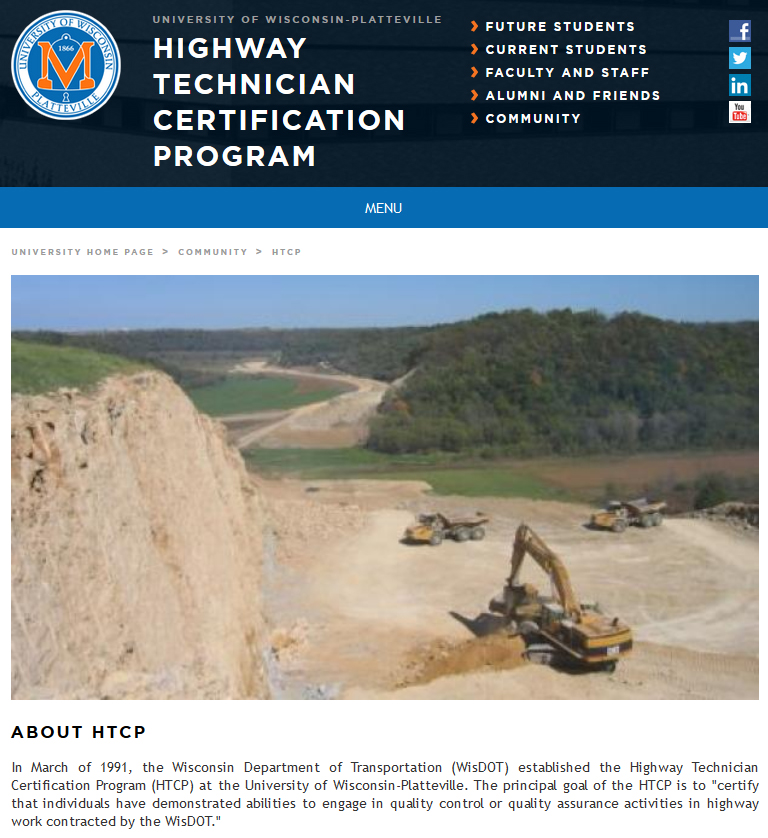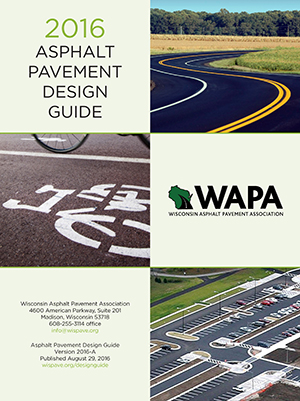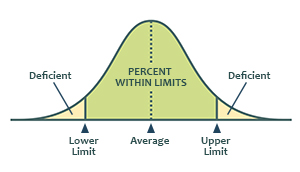
In this Executive Update we preview the WAPA 2016 Annual Conference and Awards, highlight the 2016 WAPA Design Guide, and discuss new Percent Within Limits acceptance measures.
- Annual WAPA Conference Preview
- WAPA Awards Luncheon
- Now Available: WAPA 2016 Asphalt Design Guide
- Improved Acceptance: Percent Within Limits
 The 2016 Annual WAPA Conference is coming up quickly. We hope you’ll join us November 29 and 30 at the Madison Marriott West.
The 2016 Annual WAPA Conference is coming up quickly. We hope you’ll join us November 29 and 30 at the Madison Marriott West.
There’s still time to Sign Up to Attend, Exhibit or Sponsor, but don’t delay. The hotel room block is quickly filling up; see the detailed Conference Information for hotel alternatives as well.
Thank you to our sponsors
Our sponsorships are ahead of last year’s pace (continuing an increase year after year), and we’re truly grateful for the support from our sponsors and exhibitors. This generosity and early commitment allow us to put together the best conference program possible and consistently keep registration fees at a perennially reduced rate. Our annual conference would not be possible without this continued support.
Something for everyone
The Full Conference Agenda with dates and time slots is available on our website, and we’ve listed the session titles here to provide a look at the leaders and experts who will be addressing technology, policy and funding issues.
Topics range from local and state concerns to regional, national and global issues. Sessions include annual updates (such as from WisDOT and FHWA) as well as some new items for 2016 (like global asphalt prices and plant operation practices). These together are sure to provide diverse and thought-provoking perspectives for all attendees.
General Sessions
- Welcome, Brandon Strand, WAPA Executive Director, and Brian Endres, WAPA President
- Opening Comments, Kevin Kelly, NAPA Chairman, Walsh & Kelly
- Wisconsin DOT Update, Dewayne Johnson, WisDOT Deputy Administrator for Regions
- Asphalt Specification Update, Barry Paye, WisDOT Chief Materials Engineer
- Transportation Funding Update, Eric Petersen, Wimmer & Company
- Asphalt Market Overview and Expectations, Nasreen Tasker, Argus Media
- Asphalt Pavement Alliance Update, Dan Staebell, APA Northcentral Regional Director
- Wisconsin Towns Association Update, Mike Koles, WTA Executive Director
- Federal Highway Administration Update, Mike Davies, FHWA, Division Administrator
Technical Breakout Sessions (each session will be offered twice over three time slots)
- Longitudinal Joint Construction, Mark Blow, Asphalt Institute and Signe Reichelt, Behnke Materials Engineering
- Enhanced Durability and Increased Density, Steve Hefel, WisDOT and Dave Johnson, Asphalt Institute
- Innovative Paving Programs at the Local Level, Ghassan Korban, City of Milwaukee and Todd Hughes, Payne & Dolan; Howard Crofoot, City of Platteville and Jerid Baranczyk, Iverson Construction
- Asphalt Binder Modification, Dr. Geoff Rowe, Abatech Consultant Engineers
- Plant Operations Best Practices, Steve Elam, Stansteel
- Ethics, Jeff Russell, UW-Madison
Over the course of the two-day conference, the general sessions and technical breakouts sessions listed above will provide opportunities for seven professional development hours. Add to that the unparalleled opportunities to network and connect with colleagues, and the 2016 WAPA Annual Conference is the must-attend event for asphalt professionals in Wisconsin.
We look forward to seeing you in Madison!
WAPA is bringing our Awards Luncheon to the front and center at the 2016 WAPA Annual Conference. We’re taking the opportunity on the Tuesday of our conference to celebrate both present and future asphalt pavement professionals in Wisconsin.

The Quality Management Program Award recognizes outstanding certified highway materials technicians who have displayed exceptional leadership roles in developing quality materials used in highway construction projects. Winners, chosen from contractors, consultants and WisDOT staff, display exceptional leadership roles in developing quality asphalt pavements. The award is given by WAPA in conjunction with UW-Platteville’s Highway Technician Certification Program. We look forward to recognizing two winners at the 2016 conference.
Tomorrow’s Professionals: WAPA Student Scholarships for Engineers and for Engineering Technicians
WAPA has relaunched our Student Scholarship Program for 2016. We will award two scholarships this year, a $2,000 Engineering Scholarship and a $1,000 Engineering Technician Scholarship. We’re still accepting applications, but the cutoff date is November 1. We encourage students meeting the requirements (see the program page for details) to submit an application. Thanks to WAPA members for endowing this scholarship and for encouraging the next generation of asphalt pavement professionals in Wisconsin.

- Introduction
- Quality Asphalt Pavements
- Materials for Asphalt Pavements
- Asphalt Mix Design
- Pavement Design Considerations
- Thickness Guides for Asphalt Pavements
- Pavement Management Systems
- Pavement Rehabilitation
- Asphalt for Recreational and Industrial Uses
- Materials Requirements Table
- References
The guide’s reception by Wisconsin’s asphalt pavement community has been overwhelmingly positive. While the core of this publication includes technical design details and considerations, the guide also provides context and plain-language explanations for non-technical users. This makes the 2016 Asphalt Pavement Design Guide a valuable tool not only for designers and practitioners, but also for executives and policymakers who want to understand how to make the most of asphalt pavements in Wisconsin.
WAPA has distributed the guide widely both electronically and in hardcopy format to municipal, county and state government officials and to members of industry and academia. We have also received and fulfilled numerous requests for print copies of the guide and fielded questions from across the state.
We hope you find this document useful, and we look forward to providing periodic updates in the months and years ahead as the state of practice continues to evolve in Wisconsin.
In partnership with industry and FHWA, Wisconsin DOT is modernizing asphalt pavement acceptance practices with the introduction of the percent within limits (PWL) method in our state. Engineering Director Deb Schwerman described this approach for encouraging product consistency that will soon be standard practice for larger WisDOT projects.
Statistically-driven acceptance

With PWL, lab and field measurements are taken for different parameters (such as air voids and density). A determination is made as to what percent of the measurements falls within acceptable established limits and what percent is deficient. The resulting percent within limits value is then used in a formula for a sliding scale of payment incentives and disincentives.
PWL is more discerning than other quality measures (such as Wisconsin’s current Quality Management Program). It encourages uniformity by controlling variability — a key predictor of performance. However, because PWL is data-intensive and involves frequent testing both by the asphalt producer and WisDOT, the method is being piloted for use on larger tonnage jobs — those with at least 11,250 tons per mix type. PWL also requires additional types of field testing, such as correlating core samples with nuclear gauge density test results and split testing comparisons.
Transitioning to PWL
Pilot projects in three WisDOT Regions used PWL acceptance in 2016:
- STH 32 in WisDOT’s Northeast Region
- USH 51 in WisDOT’s North Central Region
- STH 33/162 in WisDOT’s Southwest Region (in progress)
Next year there will be nearly 20 PWL projects, including at least two in each of the five WisDOT Regions. The expectation is that PWL acceptance will be used for all appropriately-sized projects in the near future (likely around 40 per year).
Wisconsin has taken a measured approach to adopting PWL acceptance, learning lessons and best practices from our neighboring states as well as others around the country and FHWA (see FHWA’s PWL Resource Page). The PWL special provisions in Wisconsin were developed to incorporate the best features of these other programs and to best meet the needs of government and industry in our state.
The smooth transition to PWL has benefitted from an effective partnership among Wisconsin’s asphalt pavement industry and state and federal government. WAPA’s members fully support PWL as a way to help achieve their mission to deliver top-quality pavements, and WAPA is committed to helping with PWL deployment. All parties have been pleased with the results so far, and we’ll report back as implementation progresses.
We hope this short update has you excited about the conference and all that’s happening with our industry in Wisconsin. As we head down the home stretch of the paving season, please don’t hesitate to contact us if you have any questions or if there is ever any way we may be of assistance.
That’s it for now. Thanks and we’ll see you soon.






